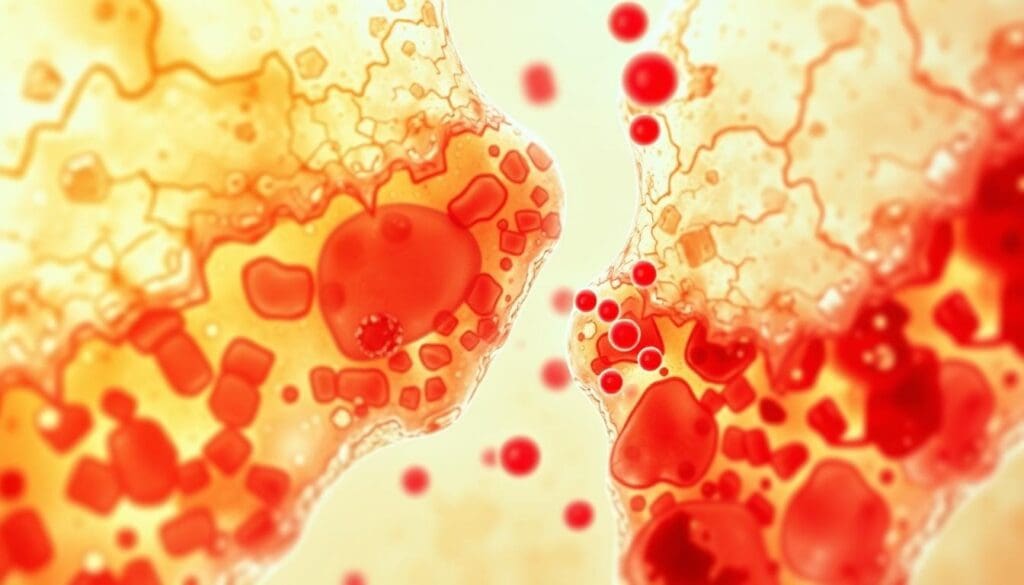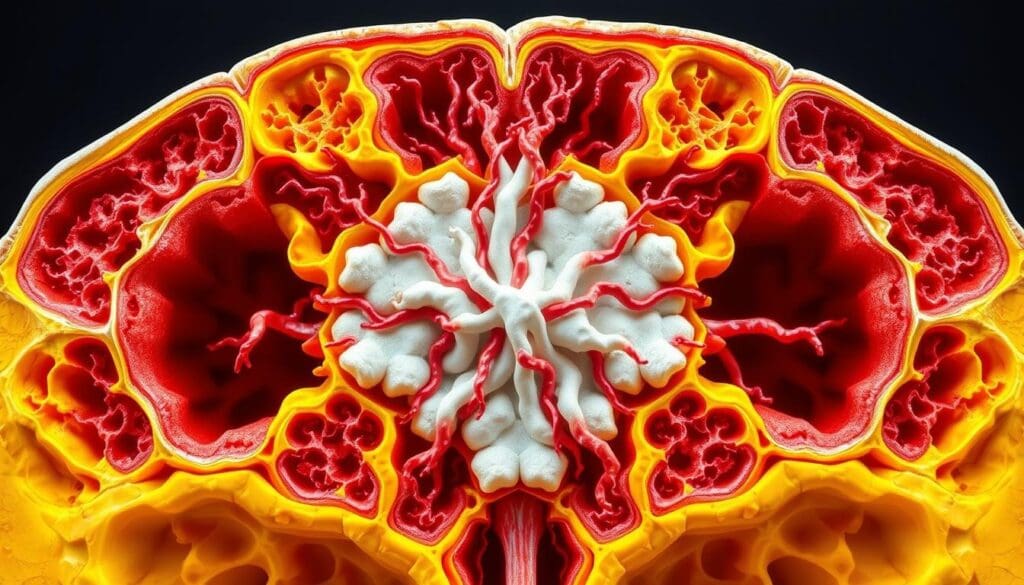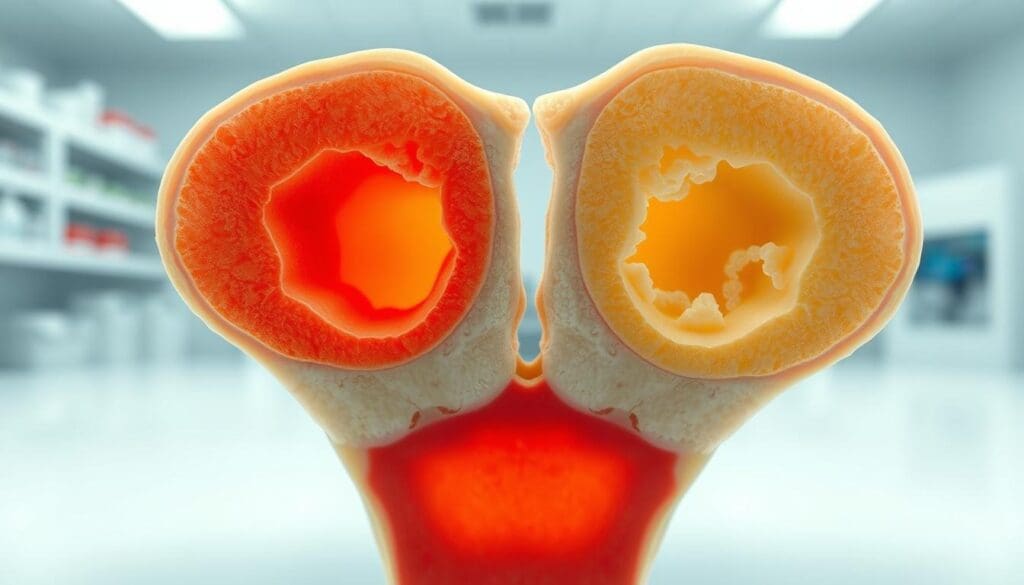Last Updated on November 17, 2025 by Ugurkan Demir

Deep inside our bones, a vital factory works hard to make the cells our bodies need. This important tissue is called bone marrow or blood marrow. It’s key to our health. There are two main types: red bone marrow and yellow bone marrow, each with its own job.
Red bone marrow makes red blood cells, white blood cells, and platelets. Yellow bone marrow, on the other hand, stores fat. It can also make red blood cells when we need them most. Knowing how these two types work helps us understand how our bodies stay

Bone marrow is like a factory inside our bones. It makes the cells we need for breathing, fighting off germs, and stopping bleeding. Knowing how it works is key to understanding its role in our health.
Bone marrow is a soft tissue inside our bones. It’s vital for making blood cells. Every day, it churns out 200 billion new blood cells. This shows just how important it is.
Red bone marrow is special because it makes red blood cells, white blood cells, and platelets. This is thanks to hematopoietic stem cells. These cells are the building blocks of blood. They help carry oxygen, fight infections, and stop bleeding.
Bone marrow has blood vessels and a stroma, which is like a framework for making blood cells. The stroma has different cells, like reticular cells and adipocytes. These cells help the stem cells grow and work properly.
The way bone marrow is made lets it make blood cells well. Knowing this helps us understand bone marrow problems and how to fix them.

The human body has two kinds of bone marrow. Each plays a key role in our health. Knowing about red and yellow bone marrow helps us understand how our body makes blood and stores energy.
Red bone marrow makes blood cells. It creates red blood cells, white blood cells, and platelets. Yellow bone marrow, on the other hand, stores energy. It’s mostly fat.
At birth, we have only red bone marrow. By age 7, yellow marrow starts to appear. By adulthood, half of our bone marrow is yellow.
Red and yellow bone marrow are different. Red marrow is full of blood vessels and stem cells. It makes blood cells. Yellow marrow is mostly fat, storing energy.
Having both red and yellow marrow is beneficial. Red marrow makes blood, while yellow marrow stores energy. Yellow marrow can also turn back into red marrow when needed.
This flexibility helps our body handle emergencies. It keeps us balanced in making blood and storing energy. It shows how well our body is designed.
Red bone marrow is key to making blood cells. It’s found in flat bones like ribs, pelvis, sternum, and long bone ends.
Red bone marrow has a network of blood vessels. It’s full of hematopoietic stem cells. These cells can turn into different blood cells, like red and white blood cells, and platelets.
This area has many cells at various stages. You’ll find:
Red bone marrow makes all our red blood cells and platelets. It also makes most of our white blood cells. The hematopoiesis process here is carefully controlled.
The main jobs of red bone marrow are:
By making these cells, red bone marrow is vital for our health.
Yellow bone marrow is filled with adipose tissue, acting as a key energy storage spot. It’s found in the long bones’ centers. Let’s dive into its makeup, roles, and special abilities.
Yellow bone marrow is mostly adipose tissue, a type of body fat. It’s made up of adipocytes, which store fat for energy. It also has mesenchymal stem cells that can create cartilage and bone, showing its flexibility.
Yellow bone marrow’s main job is to store fat for energy. This is vital for keeping energy levels balanced. Its metabolic activity is key, as it can release fat into the blood when needed.
In dire situations like severe blood loss, yellow bone marrow can turn into red bone marrow. This change lets it produce blood cells to replace lost ones. This adaptability is vital for the body’s emergency response, ensuring organs get the oxygen and nutrients they need.
In adults, bone marrow is divided into red and yellow types. Each type has its own role. The places where they are found are key to their functions.
Red bone marrow makes blood cells. It’s mainly in flat bones and the ends of long bones. You can find it in bones like the:
These spots are vital for making blood cells. This includes red blood cells, white blood cells, and platelets.
Yellow bone marrow stores fat and acts as an energy reserve. It’s found in the hollow parts of long bones. The femur and humerus are examples.
Here’s a table showing where red and yellow marrow are found:
| Bone Type | Red Marrow Presence | Yellow Marrow Presence |
| Flat Bones (e.g., Pelvis, Ribs) | Present | Absent |
| Long Bones (e.g., Femur, Humerus) | Present at the ends | Present in the shaft |
| Vertebral Column and Skull | Present | Absent |
The location of bone marrow changes as the body needs. Knowing where red and yellow marrow are helps us understand health and disease.
As we grow from infancy to adulthood, our bone marrow changes a lot. At birth, it’s mostly red marrow, which makes blood cells.
At birth, almost all bone marrow is red. This is key because red marrow makes all blood cells. It helps newborns make the blood cells they need for oxygen, fighting off infections, and clotting.
As we grow, red marrow turns into yellow marrow. By age seven, half of the red marrow is replaced by yellow. This change keeps happening until we’re adults. Yellow marrow stores energy and fills spaces where red marrow previously was.
As we get older, bone marrow changes again. In adults, red marrow is mainly in the spine, ribs, pelvis, and the top parts of long bones. Yellow marrow is in the rest, like the long bones of our arms and legs. This can change if our body needs more blood cells.
The table below shows how bone marrow changes with age:
| Stage of Life | Bone Marrow Composition | Distribution |
| At Birth | Primarily Red Marrow | All bones contain red marrow |
| Childhood (around age 7) | 50% Red Marrow, 50% Yellow Marrow | Red marrow starts converting to yellow in long bones |
| Adulthood | Red Marrow in the axial skeleton and proximal long bones; Yellow Marrow in other areas | Red marrow in vertebrae, ribs, pelvis, and proximal femur/humerus; Yellow marrow in other long bones |
Knowing about these changes helps us understand how bone marrow works at different ages. It also shows how some conditions might affect it differently at various stages of life.
Understanding bone marrow disorders is key to diagnosing and treating serious conditions. Bone marrow is vital for making blood cells. Problems here can cause serious health issues.
Bone marrow disorders affect blood cell production and function. Some common ones include:
These conditions can greatly affect a patient’s life. They often need quick and effective treatment.
To diagnose bone marrow disorders, doctors use specific procedures. These include:
These tests are vital for checking bone marrow health and diagnosing disorders.
Bone marrow transplantation is a life-saving treatment for many. It replaces a patient’s bad bone marrow with healthy bone marrow. There are two main types:
| Type of Transplant | Description |
| Autologous Transplant | Uses the patient’s own bone marrow or stem cells. |
| Allogeneic Transplant | Uses bone marrow or stem cells from a donor. |
Bone marrow transplantation has changed treatment for many blood diseases. It gives hope to those facing life-threatening conditions.
Our body’s bone marrow can change and adapt in many ways. This ensures it keeps producing healthy blood cells. This flexibility is key for our body to make blood cells when needed.
When we lose a lot of blood or need more blood cells, our body can change yellow marrow to red. This lets the bone marrow make more red blood cells, white blood cells, and platelets.
Stem cells in yellow marrow can turn into different blood cells. This ability to change yellow marrow to red is very important for emergencies.
When we lose a lot of blood or get sick, our bone marrow works harder. It makes more blood cells to keep counts healthy and help us recover.
Bone marrow’s ability to heal is very important for medicine. Bone marrow transplants, for example, save lives by treating blood disorders and cancers.
“Bone marrow transplantation has changed how we treat blood cancers and disorders. It gives patients a chance at long-term survival and better quality of life.”
The adaptability and healing power of bone marrow are exciting to study. It helps us find new treatments and therapies.
We’ve looked at the two main types of bone marrow: red and yellow. Each plays a key role in our health. Red bone marrow makes blood cells, while yellow bone marrow stores fat.
Knowing how these types work is vital. It helps us see why bone marrow health is so important.
Bone marrow is essential for our bodies to work properly. It makes the blood cells we need to live. Any problems with bone marrow can affect our health a lot.
By understanding bone marrow, we can keep it healthy. This is good for our overall health and well-being.
In short, bone marrow health is very important. By learning about red and yellow bone marrow, we can help keep our bodies healthy.
There are two types of bone marrow: red and yellow. Red bone marrow makes blood cells. Yellow bone marrow stores energy.
Red bone marrow is key to making blood cells. It produces red blood cells, white blood cells, and platelets. It has stem cells that turn into different blood cells.
In adults, red bone marrow is found in the pelvis, vertebrae, sternum, and the top parts of the femur and humerus.
Yellow bone marrow is mostly fat, acting as an energy reserve. It also has metabolic roles and can turn back to red marrow in emergencies.
At birth, most bone marrow is red. As we age, some red marrow turns into yellow. This change happens in childhood, and by adulthood, the mix of red and yellow marrow is set.
Bone marrow is vital for making blood cells. Its health is key to keeping blood cell counts healthy. Problems with bone marrow can affect overall health a lot.
Common disorders include leukemia, lymphoma, and aplastic anemia. Tests like bone marrow aspiration and biopsy help diagnose these conditions.
Yes, yellow bone marrow can turn back into red marrow in emergencies, like severe blood loss. This ability is important for keeping blood cell production healthy.
Bone marrow is key in fighting disease by making blood cells that fight infection and inflammation. Its ability to regenerate is vital for recovery from many medical conditions.
Bone marrow transplantation is a treatment that replaces damaged or diseased marrow with healthy marrow. It’s used to treat blood-related disorders and cancers.
Subscribe to our e-newsletter to stay informed about the latest innovations in the world of health and exclusive offers!